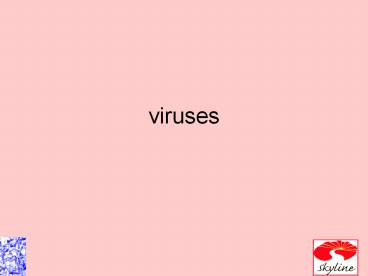viruses - PowerPoint PPT Presentation
Title:
viruses
Description:
viruses Living Nonliving Contain a single type of nucleic acid (DNA or RNA), protein coat, sometimes an envelope. Are obligatory intracellular parasites. – PowerPoint PPT presentation
Number of Views:212
Avg rating:3.0/5.0
Title: viruses
1
viruses
2
- Living
- Nonliving
3
- Contain a single type of nucleic acid (DNA or
RNA), protein coat, sometimes an envelope. - Are obligatory intracellular parasites. Multiply
by using host cells synthesizing machinery to
cause the production of specialized elements that
can transfer the nucleic acid to other cells.
4
- Multiply inside living cells by using the
synthesizing machinery of the cell. - Why does this make targeting viruses difficult?
5
Host Range
- The spectrum of host cells in which a virus can
multiply. - Mot viruses infect only specific types of cells
in one host species. - The host is determined by the specific attachment
site on the host cells surface and the
availability of host cellular factors.
6
Virus Size
Figure 13.1
7
Taxonomy of viruses
- Currently based on type of nucleic acid, strategy
for replication and morphology. - Virus family names end in viridae genus names
end in virus - A viral species is a group of viruses sharing the
same genetic information and ecological niche
8
Viral Taxonomy
- Herpesviridae
- Herpesvirus
- Human herpes virus 1, HHV 2, HHV 3
- Flue H1N1
- Retroviridae
- Lentivirus
- Human Immunodeficiency Virus 1, HIV 2
9
Isolation, growth and identification
- Must be grown on living cells.
- Easiest to grow are bacteriophage, because
bacteria are easy to grow.
10
Growth results.
- Plaques for bacteriophage.
- Cytopathic effects on cell culture.
11
Growing Viruses
- Viruses must be grown in living cells.
- Bacteriophages form plaques on a lawn of bacteria.
Figure 13.6
12
Growing Viruses
- Animal viruses may be grown in living animals or
in embryonated eggs.
Figure 13.7
13
Growing Viruses
- Animal and plants viruses may be grown in cell
culture. - Continuous cell lines may be maintained
indefinitely.
Figure 13.8
14
Identification.
- Serological tests (Antibodies)
- RFLP and PCR
- (Discussion)
15
Typical viral infection
- Attachment
- Penetration
- Biosynthesis
- Maturation
- Release
- Burst size and burst time
16
Bacterial cell wall
Bacterial chromosome
Capsid
DNA
Capsid
Sheath
Tail fiber
Tail
1
AttachmentPhage attaches to host cell.
Base plate
Pin
Cell wall
Plasma membrane
2
PenetrationPhage pnetrates host cell and
injects its DNA.
Sheath contracted
Tail core
3
Merozoites released into bloodsteam from liver
may infect new red blood cells
Figure 13.10.1
17
Tail
DNA
4
MaturationViral components are assembled into
virions.
Capsid
5
ReleaseHost cell lyses and new virions are
released.
Tail fibers
Figure 13.10.2
18
One-step Growth Curve
Figure 13.11
19
Lysogeny or Lytic?
20
The Lysogenic Cycle
Figure 13.12
21
Animal virus infection
- Attachment
- Penetration (endocytosis)
- Uncoating
- Biosynthesis
22
Attachment, Penetration, and Uncoating
Figure 13.14
23
Release of an enveloped virus by budding
Figure 13.20
24
Multiplication of DNA Virus
1
Papovavirus
Virion attaches to host cell
7
Virions are released
Host cell
DNA
Capsid
2
Virion penetrates cell and its DNA is uncoated
DNA
Cytoplasm
6
Virions mature
Capsid proteins
mRNA
5
Late translation capsid proteins are synthesized
3
Early transcription and translation enzymes are
synthesized
4
Late transcription DNA is replicated
Figure 13.15
25
Viruses and Cancer.
- Viruses incorporated in to the host genome can
cause mistakes and errors resulting in unchecked
growth of the cell. - It this accidental or are these sites targeted?
26
- Latent Viral Infections
- Virus remains in asymptomatic host cell for long
periods - Cold sores, shingles
- Persistent Viral Infections
- Disease processes occurs over a long period,
generally fatal - Subacute sclerosing panencephalitis (measles
virus)
27
Prions
- Infectious proteins
- Inherited and transmissible by ingestion,
transplant, surgical instruments - Spongiform encephalopathies Sheep scrapie,
Creutzfeldt-Jakob disease, Gerstmann-Sträussler-Sc
heinker syndrome, fatal familial insomnia, mad
cow disease - PrPC, normal cellular prion protein, on cell
surface - PrPSc, scrapie protein, accumulate in brain cells
forming plaques
28
Prions
PrPSc
PrPc
2
3
4
1
Lysosome
Endosome
5
6
7
8
Figure 13.21
29
Topics on the flue
- http//content.nejm.org/cgi/content/full/NEJMe0903
995 - NEJM N1H1 site http//h1n1.nejm.org/
- An Old presentation http//www.strongnet.org/17152
0529114210850/lib/171520529114210850/Influenza_pre
sentation.pdf































